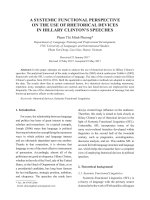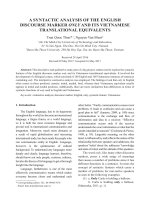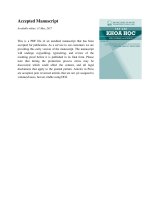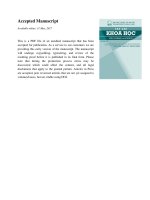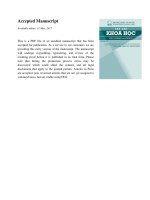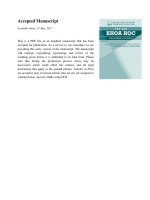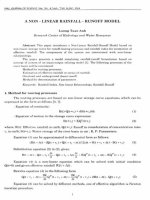DSpace at VNU: A modified anaerobic digestion process with chemical sludge pre-treatment and its modelling
Bạn đang xem bản rút gọn của tài liệu. Xem và tải ngay bản đầy đủ của tài liệu tại đây (375.87 KB, 7 trang )
2350
© IWA Publishing 2014 Water Science & Technology
|
69.11
|
2014
A modified anaerobic digestion process with chemical
sludge pre-treatment and its modelling
N. M. Hai, S. Sakamoto, V. C. Le, H. S. Kim, R. Goel, M. Terashima
and H. Yasui
ABSTRACT
Activated Sludge Models (ASMs) assume an unbiodegradable organic particulate fraction in the
activated sludge, which is derived from the decay of active microorganisms in the sludge and/or
introduced from wastewater. In this study, a seasonal change of such activated sludge constituents
in a municipal wastewater treatment plant was monitored for 1.5 years. The chemical oxygen
demand ratio of the unbiodegradable particulates to the sludge showed a sinusoidal pattern ranging
from 40 to 65% along with the change of water temperature in the plant that affected the decay rate.
The biogas production in a laboratory-scale anaerobic digestion (AD) process was also affected by
the unbiodegradable fraction in the activated sludge fed. Based on the results a chemical pretreatment using H2O2 was conducted on the digestate to convert the unbiodegradable fraction to a
biodegradable one. Once the pre-treated digestate was returned to the digester, the methane
conversion increased up to 80% which was about 2.4 times as much as that of the conventional AD
process, whilst 96% of volatile solids in the activated sludge was digested. From the experiment, the
additional route of the organic conversion processes for the inert fraction at the pre-treatment stage
was modelled on the ASM platform with reasonable simulation accuracy.
Key words
| mathematical model, partial chemical oxidation, pre-treatment, sludge constituents,
sludge minimisation
N. M. Hai
S. Sakamoto
M. Terashima
H. Yasui (corresponding author)
Faculty of Environmental Engineering,
The University of Kitakyushu,
1-1, Hibikino, Wakamatsu,
Kitakyushu 808-0135,
Japan
E-mail:
V. C. Le
Research Center for Environmental Technology
and Sustainable Development,
Hanoi University of Sciences,
Vietnam National University,
Hanoi, 334 Nguyen Trai Road,
Thanh Xuan District,
Hanoi, 10000,
Vietnam
H. S. Kim
GS E&C Research Institute,
GS Engineering & Construction Co. Ltd,
417-1, Deokseong-ri, Idon-myeon,
Cheoin-gu, Yongin-si, Gyeonggi-do, 449-831,
Korea
R. Goel
Hydromantis Environmental Software Solutions,
Inc.,
Suite 1601, 1 James Street South,
Hamilton, Ontario, L8P4R5,
Canada
INTRODUCTION
Anaerobic digestion (AD) is one of the most commonly used
processes to decompose waste activated sludge (WAS) in
municipal wastewater treatment plants (WWTPs) since it
makes it possible to reduce sludge mass for final disposal
whilst recovering biogas. Nevertheless the digestion efficiency in most conventional AD processes is still limited
to about 50%, and hence significant efforts are being made
to improve the performance. For this challenge, two engineering approaches are currently focused (Appels et al.
). One is to classify the sludge constituents by modelling
its biodegradability (Nopens et al. ) and the other is to
develop sludge pre-treatment techniques to change the
sludge properties for improving the decomposition (Bougrier et al. ; Braguglia et al. ).
doi: 10.2166/wst.2014.164
With respect to the distinction of organic particulates in
the sludge, concepts of mathematical models developed by
IWA task groups can be used (Activated Sludge Models
(ASMs) by Henze et al. () and Anaerobic Digestion
Model No.1 (ADM1) by Batstone et al. ()). The particulates are classified into unbiodegradable particulates (XU),
sets of active biomass (XBio) and sets of slowly degradable
materials (XCB). For the pre-treatment of sludge, depending
on the methods applied, the XU fraction may change to XCB
leading to a high theoretical digestion efficiency whilst a
conversion of XBio to XCB may enable high digestion rate
in the AD process. Apart from ADM1, the hydrolysis step
of XCB (solubilisation) has been traditionally assumed to
be rate-limiting of the entire reaction (Eastman & Ferguson
2351
N. M. Hai et al.
|
A modified anaerobic digestion process with chemical sludge pre-treatment
). However recent studies suggested that anaerobic
decay of the ordinary heterotrophic organisms (XOHO) in
the WAS influenced the digestion efficiency, which was
given from an analogy of ASMs (Sötemann et al. ;
Yasui et al. ). In the assumption, XOHO decays anaerobically and is converted to XCB and XU with a fixed
stoichiometry of fXU (production of inert materials from
decay). The produced XCB is then quickly hydrolysed by
the microorganisms present in the AD process where low
molecular weight substrates are eventually formed. In this
way, the model, which is an extension of the ASM concept,
expresses Eastman’s ‘hydrolysis’ as a combined reaction of
bacterial death and its external decomposition. Accordingly,
the keys to estimate the digestion efficiency of AD processes
would be the ratio of XU to total WAS organics (XOrg),
XOHO’s specific decay rate and the conversion of XU to XCB.
Based on the above theoretical consideration, when
state variables from the sludge pre-treatment module are
mapped in the AD process, the impact of the module
would be calculated in a mathematical manner. Hence a
study to engage the improved biogas production system
with modelling the sludge conversion process will help to
elucidate optimisation of the process configuration and the
selection of the appropriate pre-treatment methods. To
progress the study, a laboratory-scale conventional AD reactor (digester) was operated for 1.5 years using the WAS
having an annual change of XU/XOrg ratio, and the digestion
performance was contentiously monitored. The performance was compared to that from the modified AD reactor
equipped with a chemical sludge pre-treatment module
(advanced oxidation process). The two process responses
were then simulated using an extended ASM with a set of
new state variables produced from the sludge pre-treatment.
Water Science & Technology
|
69.11
|
2014
mesophilic AD process. Together with the aerobic tests,
tests under anaerobic condition were also conducted in
order to check consistency of the WAS constituents. For
the aerobic test, 450 mL of the WAS was placed into a
gas-tight 0.5 L medium bottle with addition of 20 mg/L of
allylthiourea to inhibit oxygen uptake by nitrifiers. The percentage of individual WAS constituents (XU, XOHO and
XCB) were estimated focusing on the chronological
response of oxygen uptake rate (OUR) that was attributed
to the decay of XOHO and degradation of XCB. The OUR
was logged at every 10 min for 5–7 days using a respirometer
with an automatic oxygen gas supply system and a strong
stirring base (AER-8, Challenging Systems, Inc., USA). For
the anaerobic tests, fresh anaerobically digested sludge was
simultaneously taken from a mesophilic anaerobic digester
at Hiagari WWTP, Japan, and its 450 mL (ca. 10,400 mgTVS/L, 17,400 mg-COD/L) was mixed with 50 mL of the
WAS. The mixture was incubated under 35 C for 5–7 days
whilst methane gas production rate (MPR) was logged at
every 30 min using the respirometer without feeding
oxygen. By subtracting the MPR of the blank test without
addition of WAS from that of the tests, the net MPR was
obtained. Due to low food:microorganism ratio of the
tests, accumulation of volatile fatty acids was negligible
over the incubation periods and hence the net MPR could
be directly interpreted as the particulate degradation rate
of the WAS.
W
Continuous AD test
Conventional AD process
A laboratory-scale continuous anaerobic digester with a
working volume of 1.8 L was operated as a conventional
AD process with chemostat mode at 35 C. The WAS collected at 7–10 day intervals from Kogasaki WWTP was
immediately centrifuged to about 20,000 mg-COD/L and
stored at 4 C. The digester was fed with the WAS every day
at 36 days of hydraulic retention time. Methane gas production from the digester was continuously logged using a
gas counter after passing it through caustic pellets to
remove CO2 in the biogas (MGC-1, Litre Meter Limited, UK).
W
MATERIAL AND METHODS
W
Estimation of XU fraction in the WAS
WAS was collected at about 2-week intervals from Kogasaki
WWTP, Japan, where a conventional biochemical oxygen
demand (BOD) removal process was operated at 5-d
sludge retention time (SRT). The collected WAS (ca.
6,000 mg total volatile solids (TVS) per litre, 9,000 mg
chemical oxygen demand (COD) per litre) was immediately
used for the batch tests to estimate XU fraction under
aerobic condition. Unlike a typical ASM procedure
(Henze et al. ), the tests were carried out under 35 C,
which was a comparable temperature to that of a typical
W
Modified AD process equipped with the pre-treatment
module and solid/liquid separation unit
As illustrated in Figure 1, another digester with a working
volume of 8.0 L equipped with a pre-treatment module
and a centrifugal solid/liquid separation unit was installed.
2352
N. M. Hai et al.
|
A modified anaerobic digestion process with chemical sludge pre-treatment
Water Science & Technology
|
69.11
|
2014
Analytical procedures
Chemical composition of sludge
Figure 1
|
Continuous anaerobic digester with the pre-treatment process.
The solid/liquid separation unit worked to extend the biological reaction time in the digester. According to Yasui
et al. (), even with SRT longer than 60 days, the XU fraction in WAS was barely biodegradable. Hence the process
configuration was appropriate to evaluate the biological
degradation of the materials from the pre-treatment.
Throughout the operation, a part of the liquor in the digester
was manually transferred to the centrifugal solid/liquid unit
and its supernatant was discharged. The rest of the portion
(thickened digestate) was pumped to the digester. During
the solid/liquid separation, a small amount of organic cationic polymer flocculants (0.034 g-polymer/g-TS (total
solids)) was added after 120 days of the start-up in order
to reduce loss of the suspended solids to the supernatant.
The digester was operated for 1.5 years under a volumetric
loading rate of about 0.55 kg-COD/(m3·d) on the basis of
the influent WAS.
For the pre-treatment process, a Fenton-like reaction
was applied in which H2O2 and Fe ions produced radicals
that partially decomposed the complex components in the
sludge (e.g. Fe2þ þ H2O2 þ [H] ! Fe3þ þ OH• þ OHÀ þ
[H] ! Fe3þ þ 2OHÀ þ Hþ;
Fe3þ þ H2O2 þ [H] ! Fe2þ þ
Hþ þ •OOH þ [H] ! Fe2þ þ 2Hþ þ OHÀ þ 0.5O2).
The
digestate to be treated was taken from the digester at 3-d
intervals which corresponded to 0.016 dÀ1 of specific
recycle rate. Ferrous chloride (FeCl2) was dosed in the initial
phase but it was discontinued when the Fe materials in the
digester accumulated to be about 5 g/L, in which the molar
ratio of Fe:H2O2 became slightly more than 1:1. As the Fe
materials seemed to be mostly precipitated in the digester,
loss of the Fe materials to the supernatant was negligible
during the experimental period (<2 mg-Fe/L in supernatant).
The H2O2 dose was set at 0.03–0.04 g-H2O2/g-TVS on the
basis of the sludge mass to be treated. A H2O2 solution
(30 wt%) was slowly mixed with the digestate for about
10–20 min. The pre-treatment temperature was set at 80 C
without pH control, and the pre-treated sludge was stored
at 4 C for 24 hours before returning to the digester.
W
W
Total and soluble volatile solids (VS) and COD concentrations were measured according to #2540 and #5220.D
in Standard Methods (APHA ), respectively. The supernatant obtained from the solid/liquid separation unit was
filtered using glass filter (Whatman GF/F). Concentration
of carbohydrates (total sugar) and peptide bonds (proteins)
in the filtrate were analysed using the phenol-sulphuric
acid method (Dubois et al. ) and microbiuret method
(Itzhaki & Gill ) respectively. The concentration of
polyphenolic compounds (humic substances) in the filtrate
was estimated by subtracting the value measured by microbiuret method from that measured by Lowry-Folin method,
which was more sensitive on phenolic groups than proteins
(Lowry et al. ). Glucose, egg albumin and alkaliextracted lignin were used for the standards for total sugar,
peptide bonds and polyphenolic compounds respectively
(Kishida Chemicals, Japan).
Dynamic simulation
Dynamic simulations of the two continuous experiments
were performed focusing on chronological changes of the
methane production and volatile solid concentration in the
digesters. For this purpose GPS-X ver.6.3 (Hydromantis
Environmental Software Solutions Inc., Canada) was used.
The reaction map developed is shown in the later section
using standardised notation by Corominas et al. ().
RESULTS AND DISCUSSION
The impact of XU fraction on the AD of WAS
As shown in Figure 2(b), the XU fractions in WAS COD
(XU/XOrg) in the aerobic tests showed a sinusoidal response
varying from 40 to 65% with a half-width of 0.5 year according to the change of water temperature at the WWTP. The
lowest XU/XOrg ratio (40%) was observed when water temperature was also a minimum at 14 C, whilst the highest
XU/XOrg ratio (65%) was seen in high water temperature,
suggesting more decay took place. The plots of XU/XOrg
ratio in the aerobic tests showed a comparative pattern to
those in the anaerobic tests, and its regression with the
anaerobic dataset was y ¼ 0.99x (r 2 ¼ 0.83) (data not
shown). These indicated that XU/XOrg ratio based on the
W
2353
Figure 2
N. M. Hai et al.
|
|
A modified anaerobic digestion process with chemical sludge pre-treatment
Water Science & Technology
|
69.11
|
2014
Sinusoidal responses of (a) water temperature in the wastewater treatment plant and (b) XU/XOrg ratio of activated sludge, (c) methane production rate (NL: normal litre), (d) TVS
concentration and (e) the COD mass balance in the conventional AD process; ◯ ¼ measured, – ¼ simulated.
ASM concept could be direct information to estimate the
AD efficiency of the WAS.
Based on the results, a dynamic simulation of MPR and
TVS concentration for the conventional AD process was conducted where 0.21 dÀ1 of anaerobic specific decay rate for
XOHO was applied, which was the average in the batch
anaerobic tests. Both MPR and TVS concentration in the
digester were successfully simulated, as shown in Figure 2(c)
and 2(d) respectively. Therefore the XU/XOrg ratio was
thought to be one of the most influential factors on the digestion performance. Although the MPR fluctuated due to
fluctuation of the influent WAS concentration over the experiment, on average about 33% of the WAS COD was converted
to methane, as shown in Figure 2(d).
The digestion efficiency of the modified AD process
For the modified AD process equipped with the pretreatment module, as shown in the left graphs of Figure 3
in which the dynamic simulations were also drawn, the
conversion of WAS to biogas was remarkably improved.
Throughout the experimental period of 1.5 years, a precise
COD mass balance was obtained as shown in the right
graph of the figure. Between 70 and 80% of WAS COD
was converted to methane whereas 16–26% of the WAS
COD was retained in soluble materials, depending on the
H2O2 dose at the pre-treatment. The remaining particulate
COD in the graph was attributed to the sludge sampling
for the chemical analysis and the loss in the effluent
stream. On average, about 96% of TVS compounds in the
WAS was digested to gaseous and/or liquid form with the
experiment for H2O2 dose at 0.04 g-H2O2/g-TVS. The
methane conversion efficiency slightly decreased under the
operation when H2O2 dose was reduced to 0.03 g-H2O2/gTVS, suggesting that H2O2 dose affected the conversion stoichiometry of XU to biodegradable materials.
The chemical analysis of the soluble fraction revealed
that the dominant soluble COD of the supernatant was polyphenolic compounds accounting for 52.4% of the total
whereas 11.4% of COD was detected as sugar and 16.2%
2354
Figure 3
N. M. Hai et al.
|
|
A modified anaerobic digestion process with chemical sludge pre-treatment
|
|
69.11
|
2014
(a) Methane production rate (NL: normal litre), (b) TVS concentration and (c) the COD mass balance in the modified AD process; ◯ ¼ measured, – ¼ simulated.
as proteins respectively. Twenty per cent of COD was
retained as unidentified fraction. As the BOD concentration
of the supernatant was a negligible level (data not shown),
most of the soluble COD was thought to be unbiodegradable organics (SU). Since monomer sugar and normal
proteins are supposed to be biodegradable, the results
suggested that the SU molecules were quite complex. A
future study to compare the molecule structure with that
of ordinary XU might give chemical insights for the refractory organics.
Figure 4
Water Science & Technology
The development of a process model
For the reaction map as shown in Figure 4, the oxidant
(H2O2, SOxidant) was assumed to convert the COD particulates (composite, XOrg) in the sludge into two kinds of
slowly hydrolysable materials (XCB_Ss and XCB_Su) leading
to substrates (SS,ACO) for acidifier and soluble unbiodegradable organics (SU) respectively. The model included two
essential additional stoichiometries which depended on
the dose and/or type of oxidants, i.e. a loss of COD by the
Reaction map of the AD process with the pre-treatment module (COD basis). XBio: Microorganisms in WAS, XOrg: Organic particulates in the AD sludge (composite), XU:
Unbiodegradable organic particulates, XACO: Acidogens, XMEO: Methanogens, XCB, XCB_Ss and XCB_Su: Slowly hydrolysable materials, SOxidant: Oxidant (negative COD), SS,ACO:
Substrate for acidogens, SS,MEO: Substrate for methanogens, SU: Soluble unbiodegradable organics, SCH4: Methane, fOxidant: Loss of COD by the oxidant (–), fU: Production of inert
materials from decay (–), fUOxidant: COD loss by the oxidant (–), fXCB_Ss: Production of very slowly hydrolysable materials from the pre-treatment (–) YACO: Yield of acidogens (–),
YMEO: Yield of methanogens (–).
2355
N. M. Hai et al.
|
A modified anaerobic digestion process with chemical sludge pre-treatment
oxidant (fOxidant) and an efficiency of the conversion
(fXCB_Ss). After reacting with the oxidant, the remaining
COD in XOrg (¼(1–fOxidant)·XOrg) was mapped to XCB_Ss
and XCB_Su with the ratio of (fXCB_Ss:1–fXCB_Ss). Since a
considerable SU fraction was produced from the modified
AD process, its production route was made as 1–fXCB_Ss.
Although the stoichiometry might be affected by the
sludge composition of XOrg, for simplification it was
assumed that the conversion was a function of only oxidant
dose in this study. The fXCB_Ss used for the graphs was
0.77 g-COD/g-COD at 0.04 g-H2O2/g-TVS and 0.60 gCOD/
gCOD at 0.03 g-H2O2/g-TVS respectively.
With respect to the process rate expressions for XCB_Ss
and XCB_Su, both were assumed to be Contois-type having
identical kinetics, which was a comparable structure to
that of the hydrolysis of decayed products from WAS organics in ASMs. The kinetics were selected to fit the VS
concentration in the digester whilst calibrating the conversion coefficient of fXCB_Ss to meet the soluble COD in the
supernatant. It appeared that the process rate for the particulate degradation of the pretreated sludge was very low.
The maximum specific hydrolysis rate (0.8 dÀ1) for compounds was remarkably lower than that adapted from
ASMs (6.0 dÀ1, at 35 C). Also the half-saturation coefficient
(1.0 g-COD/g-COD) was much higher than the typical value
of 0.035 g-COD/g-COD, suggesting that a first-order type
expression could be alternatively applied.
It was noted that sensitivities for the growth-relating
parameters and the decay-relating parameters for the two
types of anaerobic microorganisms (acidogens: XACO; and
methanogens: XMEO) were low when calculating the sludge
concentration in the digester. This was because the SRT of
the digesters was almost fixed over the experiments and
the XCB_Ss, XCB_Su and XU fractions were the dominant particulate COD in the digester. Consequently literature-based
values were roughly adopted for the simulations with stoichiometric coefficients (g-COD/g-COD): YACO ¼ 0.14,
YMEO ¼ 0.09, fU ¼ 0.08; growth kinetics (dÀ1, mgCOD/L):
μACO,max ¼ 4.0, KS,ACO ¼ 10, μMEO,max ¼ 0.37, KS,MEO ¼ 20,
decay kinetics (dÀ1): bACO ¼ 0.1, bMEO ¼ 0.1 (Batstone et al.
; Siegrist et al. ).
W
CONCLUSIONS
Using WAS taken from the municipal WWTP, a kinetic
response of the AD processes was studied and the following
results were obtained.
Water Science & Technology
|
69.11
|
2014
1. The fraction of unbiodegradable organic particulates
(XU) in the WAS showed a sinusoidal curve over a year,
having a range between 40 and 65%. The response was
almost identical to the seasonal variation of water temperature (14–27 C) in the WWTP, which was explained by
the decay of biomass, leading to both slowly degradable
and inert COD, being more predominant at higher temperature. The AD efficiency of the conventional AD
process was particularly influenced by the XU fraction
in the activated sludge fed.
2. When applying H2O2 and Fe ions to the sludge pretreatment as a partial oxidation of XU, the methane conversion efficiency was improved up to 80%, which was about
2.4 times as much as that of the conventional AD process.
On the other hand, a considerable amount of soluble unbiodegradable organics was also built in the system, which
accounted for 20% of the activated sludge fed.
3. Based on the dynamic responses of the continuous experiments, a reaction map including anaerobic sludge
digestion and pre-treatment was formulated on the ASM
platform. The model demonstrated that the improvement
of the digestion was attributed to the conversion of the
XU fraction to biodegradable ones. The production of soluble inert was also calculated. The approach to modelling
can be extended in future studies to evaluate system performances for various kinds of modified AD processes
with a sludge pre-treatment module.
W
ACKNOWLEDGEMENT
This work was supported by the Japan Society for the Promotion of Science (Grants-in aid for scientific research,
No. 22404003 and 22254004).
REFERENCES
APHA Standard Methods for the Examination of Water and
Wastewater, 21st edn, American Public Health Association/
American Water Works Association/Water Environment
Federation, Washington, DC, USA.
Appels, L., Baeyens, J., Degreve, J. & Dewil, R. Principles and
potential of the anaerobic digestion of waste-activated sludge.
Prog. Energy Comb. Sci 34, 755–781.
Batstone, D. J., Keller, J., Angelidaki, I., Kalyuzhnyi, S. V.,
Pavlostathis, S. G., Rozzi, A., Standers, W. T. M., Siegrist, H.
& Vavilin, V. A. Anaerobic Digestion Model No.1
(ADM1). IWA Scientific and Technical Report No. 13. IWA,
London, UK.
2356
N. M. Hai et al.
|
A modified anaerobic digestion process with chemical sludge pre-treatment
Bougrier, C., Battimelli, A., Delgenes, J. P. & Carrere, H.
Combined ozone pretreatment and anaerobic digestion for
the reduction of biological sludge production in wastewater
treatment. Ozone: Sci. Eng. 29 (3), 201–206.
Braguglia, C. M., Gagliano, M. C., Gallipoli, A. & Rossetti, S.
Enhanced anaerobic digestion performances: Effect of sludge
ultrasound pre-treatment and role of the microbial
population. Environ. Eng. Manag. J. 11 (10), 1803–1810.
Corominas, L., Rieger, L., Takács, I., Ekama, G., Hauduc, H.,
Vanrolleghem, P. A., Oehmen, A., Gernaey, K. V., van
Loosdrecht, M. C. M. & Comeau, Y. New framework for
standardized notation in wastewater treatment modelling.
Water Sci. Technol. 61 (4), 841–857.
Dubois, M., Giles, K. A., Hamilton, J. K., Roberts, P. A. & Smith, F.
Colorimetric method for determination of sugars and
related substances. Analyt. Chem. 28 (3), 350–356.
Eastman, J. A. & Ferguson, J. F. Solubilization of particulate
organic carbon during the acid phase of anaerobic digestion.
J. Water Pollut. Control Fed. 53, 352–366.
Henze, M., Gujer, W., Mino, T. & Loosdrecht, M. Activated
Sludge Models ASM1, ASM2, ASM2D, ASM3. IWA
Scientific and Technical Report No. 9. IWA, London, UK.
Water Science & Technology
|
69.11
|
2014
Itzhaki, R. F. & Gill, D. M. A micro-biuret method for
estimating proteins. Analyt. Biochem. 9, 401–410.
Lowry, O. H., Rosebrough, N. J., Farr, A. L. & Randall, R. J.
Protein measurement with the Folin phenol reagent. J. Biol.
Chem. 193, 265–275.
Nopens, I., Batstone, D. J., Copp, J. B., Jeppsson, U., Volcke, E.,
Alex, J. & Vanrolleghem, P. A. An ASM/ADM model
interface for dynamic plant-wide simulation. Water Res. 43
(7), 1913–1923.
Siegrist, H., Vogt, D., Garcia-Heras, J. L. & Gujer, W.
Mathematical model for meso- and thermophilic anaerobic
sewage sludge digestion. Environ. Sci. Technol. 36, 1113–1123.
Sötemann, S. W., Ristow, N. E., Wentzel, M. C. & Ekama, G. A.
A steady state model for anaerobic digestion of sewage
sludges. Water SA 31 (4), 511–528.
Yasui, H., Komatsu, K., Goel, R., Li, Y. Y. & Noike, T. Fullscale verification of modified anaerobic digestion process
with ozonation to minimize sludge cake production. Environ.
Eng. Res. 42, 385–393.
Yasui, H., Sugimoto, M., Komatsu, K., Goel, R., Li, Y. Y. & Noike,
T. An approach for substrate mapping between ASM
and ADM1 for sludge. Water Sci. Technol. 54 (4), 83–92.
First received 27 November 2013; accepted in revised form 13 March 2014. Available online 29 March 2014

